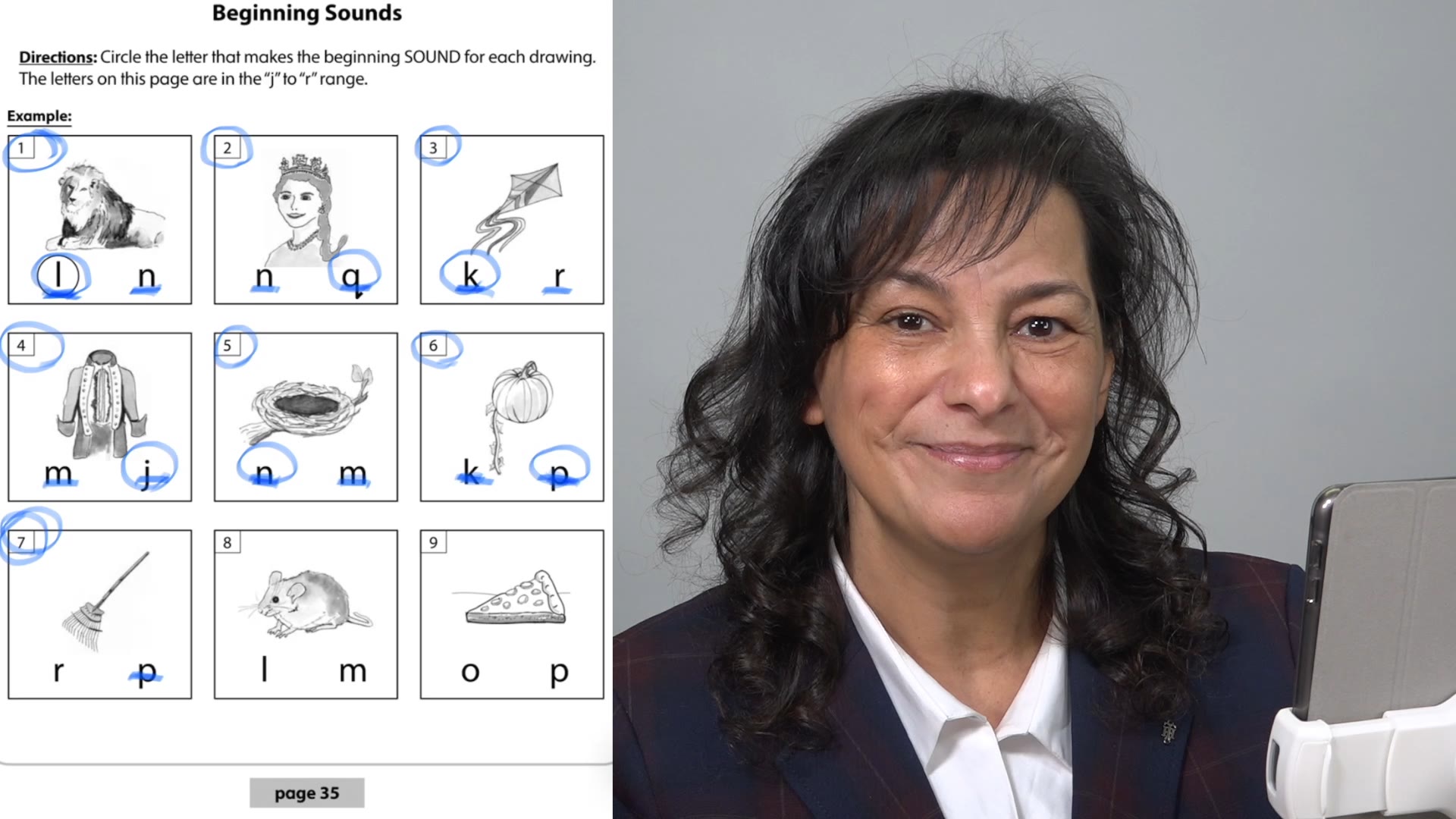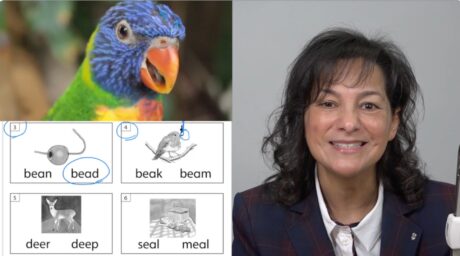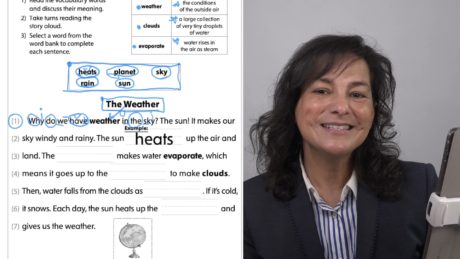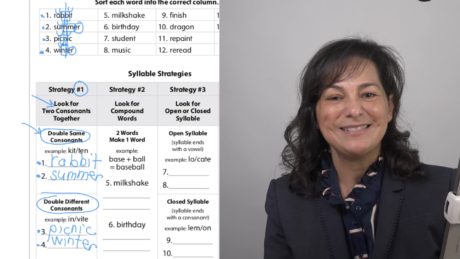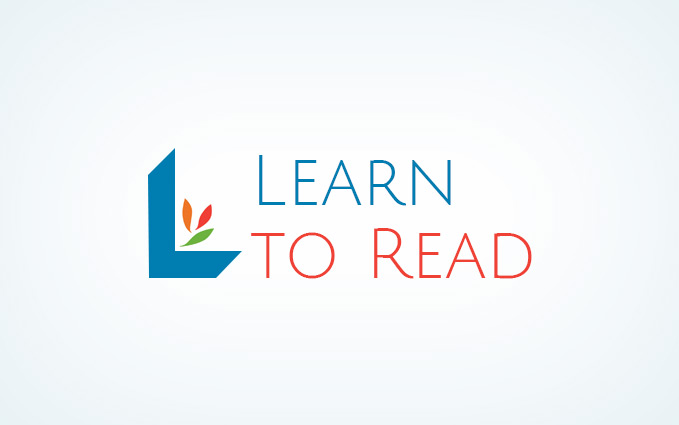The Startup Reading Letter Names and Sounds Workbook, Book 1, is designed for young learners to engage with both the names and sounds of each letter. Students learn that every letter has two jobs: it has a name, and it has a sound.
We recommend starting the lessons in Book 1 with a “Warm-Up” by singing the ABC song. This fun warm-up helps engage young children in the lessons.
Generally, younger students do best when practicing a few activities in Lesson 1 for about 15-20 minutes. A parent can gauge their child’s level of engagement to determine how many video lessons and activities to complete at a time.
Our experience has been that young learners have fun and connect to the lessons in Book 1 by starting sessions with a “Warm-up” by singing the ABC song.
Our experience has been that younger students generally do best when practicing a few activities in Lesson 1 for about 15-20 minutes. A parent can determine their child’s level of engagement to determine how many video lessons and activities to complete at a time.
The key component of the student learning experience is to have your child complete the activities as they are watching the videos. Each lesson starts with an overview of the lesson, directions on the correct workbook page, and a confirmation that the student will follow the lesson by making notations on the page.
Course Curriculum
| Lesson 1: The First Steps in Learning to Read | |||
| Page 1, Letter Names Skill Chart – B1, 1.01.1 | 00:03:00 | ||
| Warm-Up: Sing the ABC Song (this video includes other students singing the ABC song in a group setting) In the Letter Names and Sounds workbook, the skill chart with the Letter Names has the upper and lowercase letters. This encourages students to understand that both the upper and lower case letters have the same name for students to develop the understanding in learning to associate the upper and lowercase letters together having the same name. Throughout the lessons, we make a clear distinction between the name of a letter and the sound a letter makes. In this lesson, students sing the ABC song to establish the most basic foundation for learning to read: learning that the letters of the alphabet have two jobs, they have a name and a sound. | |||
| Pages 6-16, Imaginary Picture Story Letters A-I, B11.01.2 | FREE | 00:05:00 | |
| In this lesson students are introduced to the consonant sounds of the letters A-I through the Imaginary Picture Story. The Imaginary Picture story is the foundation of each lesson. We use the story to establish the connection between a letter and its sound as part of experiencing the story. The images in the story become a primary reference point for teaching and reinforcing the sounds of each letter throughout the Startup Reading series of lessons. Optional: Your child can color the pictures on pages 6-16. | |||
| PAge 6-17 Beginning Sounds in the “a” to “i”, B1, 1.01.3 | 00:13:00 | ||
| In this lesson, students will associate the beginning sound of a word with a picture. This activity has three purposes: 1) to prepare students to follow directions, 2) to teach students to identify the beginning sound in a word, and 3) to encourage students to associate the beginning sound of a word with a picture. | |||
| Page 1, Letter Names Skill Chart B1, 1.02.1 | 00:03:00 | ||
| Warm-Up: Sing the ABC Song (this video includes other students singing the ABC song in a group setting) | |||
| Page 1, Uppercase and Lowercase Letters A-I, B1, 1.02.2 | 00:08:00 | ||
| In this lesson students practice the concept that each letter has an uppercase and a lowercase form. It’s important to emphasize, sometimes the upper case letters have the same shape as their lowercase letters, and sometimes they have a different shape. We have found that “same or different” is a concept that young learners understand and can easily apply to new information. | |||
| Page 18,Beginning Sounds in range of “a” to “i”, B1, 1.02.2 | FREE | 00:13:00 | |
| In this lesson, students will associate the beginning sound of a word with a picture. This activity has two purposes: 1) to teach students to identify the beginning sound in a word, and 2) to encourage students to associate the beginning sound of a word with a picture. | |||
| Page 1, Letter Names Skill Chart – 1.03.1 | 00:03:00 | ||
| 1) Sing the ABC Song Warm-Up (this video includes other students singing the ABC song in a group setting) | |||
| Page 1, Hop to each letter on – B1, 1.03.2 | 00:04:00 | ||
| In this lesson, students point or “hop” from one letter to the next focusing on the letter visually as they say its name. The letter names are the essential foundation for students to learn to read. | |||
| Page 19, Upper and Lowercase letter names-B1, 1.03.3 | 00:08:00 | ||
| In this lesson, students will match the upper- and lowercase letters. The objective is for students to recognize that a letter, for example, “A” has two shapes of one letter: an uppercase and lowercase shape. This will help them later on when they learn to print because they will be comfortable with the concept of a single letter having two shapes. | |||
| Page 1, Letter Names Skill Chart Review, B1, 1.04.1 | 00:03:00 | ||
| Sing the ABC Song Warm-Up (this video includes other students singing the ABC song in a group setting) | |||
| Page 1, Hop to each letter, B1, 1.04.2 | 00:04:00 | ||
| In this lesson, students point or “hop” from one letter to the next focusing on the letter visually as they say its name. The letter names are the essential foundation for students to learn to read. | |||
| Page 20, Upper and Lowercase Letter Names – B1, 1.04.3 | 00:09:00 | ||
| In this lesson, students will match the upper- and lowercase letters. | |||
| Page 1, Letter Names Skill Chart Review – B1, 1.05.1 | 00:03:00 | ||
| Sing the ABC Song (this video includes other students singing the ABC song in a group setting) | |||
| Page 1, Hop to each letter, B1, 1.05.2 | 00:04:00 | ||
| In this lesson, students point or “hop” from one letter to the next focusing on the letter visually as they say its name. The letter names are the essential foundation for students to learn to read. | |||
| Page 21, Matching Upper and Lowercase Letters – B1, 1.05.3 | FREE | 00:13:00 | |
| In this lesson, students will practice the letter names through a worksheet which asks them to draw a line from the upper- case to the lower- case letter. We remind students that one way to match the letters is by noticing which uppercase and lowercase letters have the same shape and which letters have a different shape. | |||
| Page 1, Letter Names Skill Chart Review – B1, 1.06.1 | 00:03:00 | ||
| Sing the ABC Song Warm-Up (this video includes other students singing the ABC song in a group setting) | |||
| Page 1, Hop to each letter, B1, 1.06.2 | 00:04:00 | ||
| In this lesson, students point or “hop” from one letter to the next focusing on the letter visually as they say its name. The letter names are the essential foundation for students to learn to read. | |||
| Page 22, Matching Upper and Lowercase Letters – B1, 1.06.3 | 00:13:00 | ||
| In this lesson, students match upper- and lowercase letters with a “cut & paste” activity. There are three purposes: To match the upper and lower case letters Practice using scissors to cut out the lowercase letter squares To make a visual connection between an uppercase and lowercase letter. | |||
| Lesson 2: Continuing with the Imaginary Picture Story, J-R | |||
| Page 1, Upper and Lower Case Letters A-R, B1, 2.01.1 | 00:11:00 | ||
| In this lesson students will review the letters A-I from Lesson 1 and practice the letters J-R as part of Lesson 2 in the concept that each letter has an uppercase and a lowercase form. It’s important to emphasize, sometimes the upper case letters have the same shape as their lowercase letters, and sometimes they have a different shape. We have found that “same or different” is a concept that young learners understand and can easily apply to new information. | |||
| Pages 24-33, Imaginary Picture Story Letters J-R – B1, 2.01.2 | 00:04:00 | ||
| In this lesson students are introduced to the consonant sounds of the letters J-R through the Imaginary Picture Story. The Imaginary Picture story is the foundation of each lesson. We use the story to establish the connection between a letter and its sound as part of experiencing the story. Optional: Your child can color the pictures on pages 24-33 | |||
| Page 34, Match the Beginning Letters, “J”to “R”, to the Picture – B1, 2.01.3 | 00:11:00 | ||
| In this lesson, students will associate the beginning sound of a word with a picture. This activity has two purposes: 1) to teach students to identify the beginning sound in a word, and 2) to encourage students to associate the beginning sound of a word with a picture. | |||
| Page 1, Letter Names & Sounds Skill Chart – B1, 2.02.1 | 00:03:00 | ||
| Warm-up: Sing the ABC Song (this video includes other students singing the ABC song in a group setting) | |||
| Page 1, Hop to each letter and say its name – B1, 2.02.2 | 00:04:00 | ||
| In this lesson, students point or “hop” from one letter to the next focusing on the letter visually as they say its name. The letter names are the essential foundation for students to learn to read. | |||
| Page 35, Match the Beginning Sounds to the Letters “J” to “R”, B1, 2.02.3 | 00:12:00 | ||
| In this lesson, students will associate the beginning sound of a word with a picture. This activity has two purposes: 1) to teach students to identify the beginning sound in a word, and 2) to encourage students to associate the beginning sound of a word with a picture. | |||
| Page 1, Review: The ABC Letters and Sounds – B1, 2.03.1 | 00:03:00 | ||
| 1)Warm-up: Sing the ABC Song (this video includes other students singing the ABC song in a group setting) | |||
| 2.03.2 Hop to each letter and say its name – Page 1 | 00:04:00 | ||
| In this lesson, students point or “hop” from one letter to the next focusing on the letter visually as they say its name. The letter names are the essential foundation for students to learn to read. | |||
| Page 36, Match the Upper and Lowercase letters-B1, 2.03.3 | 00:11:00 | ||
| In this lesson, students will match the upper- and lowercase letters. The objective is for students to recognize that a letter, for example, “R” has two shapes of one letter: an uppercase and lowercase shape. This will help them later on when they learn to print because they will be comfortable with the concept of a single letter having two shapes. | |||
| 2.04.1 Review: The ABC Letters & Sounds – Page 1 | 00:03:00 | ||
| 1)Warm-up: Sing the ABC Song (this video includes other students singing the ABC song in a group setting) | |||
| Page 1, Hop to each letter and say its name – B1, 2.04.2 | 00:04:00 | ||
| In this lesson, students point or “hop” from one letter to the next focusing on the letter visually as they say its name. The letter names are the essential foundation for students to learn to read. | |||
| Page 37, Match the upper and lowercase letter names J-R, B1, 2.04.3 | 00:12:00 | ||
| In this lesson, students will match the upper- and lowercase letters. The objective is for students to recognize that a letter, for example, “M” has two shapes of one letter: an uppercase and lowercase shape. This will help them later on when they learn to print because they will be comfortable with the concept of a single letter having two shapes. | |||
| Page 1, Sing the ABC Song – B1, 2.05.1 | 00:03:00 | ||
| Warm-Up: Sing the ABC Song (this video includes other students singing the ABC song in a group setting) | |||
| Page 1, Hop to each letter and say its name – B1, 2.05.2 | 00:04:00 | ||
| In this lesson, students point or “hop” from one letter to the next focusing on the letter visually as they say its name. The letter names are the essential foundation for students to learn to read. | |||
| Page 38, Cut and paste the matching letters, B1, 2.05.3 | 00:12:00 | ||
| Letter Names and Sounds : Lesson Plan 11 - Cut and paste the matching Upper and Lowercase Letters In this lesson, students match upper- and lowercase letters with a “cut & paste” activity. There are three purposes: To match the upper and lower case letters Practice using scissors to cut out the lowercase letter squares To make a visual connection between an upper and lowercase letter. | |||
| Lesson 3: Completing the Imaginary Picture Story, S-Z | |||
| Page 1, Review Upper and Lower Case Letters A-Z – B1, 3.01.1 | 00:11:00 | ||
| In this lesson students will review the letters A-I from Lesson 1 and practice the letters J-R as part of Lesson 2 in the concept that each letter has an uppercase and a lowercase form. It’s important to emphasize, sometimes the upper case letters have the same shape as their lowercase letters, and sometimes they have a different shape. We have found that “same or different” is a concept that young learners understand and can easily apply to new information. | |||
| Pages 40-48, Imaginary Picture Story Letters S-Z, B1, 3.01.2 | 00:05:00 | ||
| In this lesson students are introduced to the consonant sounds of the letters S-Z through the Imaginary Picture Story. The Imaginary Picture story is the foundation of each lesson. We use the story to establish the connection between a letter and its sound as part of experiencing the story. Optional: Your child can color the pictures on pages 40-48 | |||
| Page 49, Match the Sounds to the Letters S to Z – B1, 3.01.3 | 00:17:00 | ||
| In this lesson, students will associate the beginning sound of a word with a picture. This activity has two purposes: 1) to teach students to identify the beginning sound in a word, and 2) to encourage students to associate the beginning sound of a word with a picture. | |||
| Page 1, Review: the ABC Letters & Sounds, B1, 3.02.1 | 00:03:00 | ||
| Warm-up: Sing the ABC Song (this video includes other students singing the ABC song in a group setting) | |||
| Page 1, Hop to each letter and say its name – B1, 3.02.2 | 00:04:00 | ||
| In this lesson, students point or “hop” from one letter to the next focusing on the letter visually as they say its name. The letter names are the essential foundation for students to learn to read. | |||
| Page 50, Match the Sounds to the Letters S to Z – B1, 3.02.3 | 00:12:00 | ||
| In this lesson, students will associate the beginning sound of a word with a picture. This activity has two purposes: 1) to teach students to identify the beginning sound in a word, and 2) to encourage students to associate the beginning sound of a word with a picture. | |||
| Page 1, The ABC Letter Names Skill Chart – B1, 3.03.1 | 00:03:00 | ||
| 1)Warm-up: Sing the ABC Song (this video includes other students singing the ABC song in a group setting) | |||
| Page 1, Hop to each letter and say its name – B1, 3.03.2 | 00:04:00 | ||
| In this lesson, students point or “hop” from one letter to the next focusing on the letter visually as they say its name. The letter names are the essential foundation for students to learn to read. | |||
| Page 51, Match the Upper and Lowercase letter – B1, 3.03.3 | 00:10:00 | ||
| In this lesson, students will match the upper- and lowercase letters. The objective is for students to recognize that a letter, for example, “T” has two shapes of one letter: an uppercase and lowercase shape. This will help them later on when they learn to print because they will be comfortable with the concept of a single letter having two shapes. | |||
| Page 1, Sing the ABC Song – B1, 3.04.1 | 00:03:00 | ||
| 1)Warm-up: Sing the ABC Song (this video includes other students singing the ABC song in a group setting) | |||
| Page 1, Hop to each letter – B1, 3.04.2 | 00:04:00 | ||
| In this lesson, students point or “hop” from one letter to the next focusing on the letter visually as they say its name. The letter names are the essential foundation for students to learn to read. | |||
| Page 52, Match the Upper and Lowercase letters S-Z – B1, 3.04.3 | FREE | 00:11:00 | |
| In this lesson, students will match the upper- and lowercase letters. The objective is for students to recognize that a letter, for example, “T” has two shapes of one letter: an uppercase and lowercase shape. This will help them later on when they learn to print because they will be comfortable with the concept of a single letter having two shapes. | |||
| Page 1, Sing the ABC Song – B1, 3.05.1 | 00:03:00 | ||
| 1)Warm-up: Sing the ABC Song (this video includes other students singing the ABC song in a group setting) | |||
| Page 1, Hop to each letter and say its name – B1, 3.05.2 | 00:04:00 | ||
| In this lesson, students point or “hop” from one letter to the next focusing on the letter visually as they say its name. The letter names are the essential foundation for students to learn to read. | |||
| Page 53, Matching Upper and Lowercase Letters – B1, 3.05.3 | 00:16:00 | ||
| Letter Names and Sounds : Lesson Plan 16 - Matching Upper and Lowercase Letters In this lesson, students match upper- and lowercase letters with a “cut & paste” activity. There are three purposes: To match the upper and lower case letters Practice using scissors to cut out the lowercase letter squares To make a visual connection between an upper and lowercase letter. | |||
| Lesson 4: Review our Consonant and Vowel Friends | |||
| Page 56n Introduction to the Vowels, B1, 4.01.1 | 00:12:00 | ||
| In this lesson, we will introduce students to the vowels for the first time and teach them to differentiate between vowels and consonants. The ability for a student to identify a letter as a vowel or a consonant is essential to their foundation in learning to read. | |||
| Page 2, Revisit the Consonant Sounds, B1, 4.01.2 | 00:04:00 | ||
| In this lesson, students will make an association between the name of a letter, the consonant sound the letter makes and the imaginary picture image of the letter in a fun systematic way. We have found this approach to be effective for students to practice and recall these key concepts in the foundation of learning to read. Important note: Some children pronounce consonants followed with an /uh/ sound. It is normal to make a consonant sound louder by adding an /uh/” sound. That /uh/ sound should be diminished. To address this potential habit, we use “helpful hints” to model the consonant sound of each letter and we ask students to be our echo for them to hear the sounds of the letters correctly. | |||
| Page 2, Revisit the Consonant Sounds – B1, 4.02.1 | 00:04:00 | ||
| In this lesson, students will make an association between the name of a letter, the consonant sound the letter makes and the imaginary picture image of the letter in a fun systematic way. We have found this approach to be effective for students to practice and recall these key concepts in the foundation of learning to read. Important note: Some children pronounce consonants followed with an /uh/ sound. It is normal to make a consonant sound louder by adding an /uh/” sound. That /uh/ sound should be diminished. To address this potential habit, we use “helpful hints” to model the consonant sound of each letter and we ask students to be our echo for them to hear the sounds of the letters correctly. | |||
| xPage 57, Beginning Sounds Review – B1, 4.02.2 | 00:12:00 | ||
| In this lesson, students will associate the beginning sound of a word with a picture. This activity has two purposes: 1) to teach students to identify the beginning sound in a word, and 2) to encourage students to associate the beginning sound of a word with a picture. Most often, lower case “b” and lower case “d” are difficult for students to distinguish. To address this potential confusion, we draw short, slanted lines behind the line of the “b” to show students it is like the “b-b-b-back of a bear.” In the circle in the lowercase “d,” we draw a cute little “d-d-dog’s face.” | |||
| Page 2, Revisit the Consonant Sounds Skill Chart – B1, 4.03.1 | 00:04:00 | ||
| In this lesson, students will make an association between the name of a letter, the consonant sound the letter makes and the imaginary picture image of the letter in a fun systematic way. We have found this approach to be effective for students to practice and recall these key concepts in the foundation of learning to read. Important note: Some children pronounce consonants followed with an /uh/ sound. It is normal to make a consonant sound louder by adding an /uh/” sound. That /uh/ sound should be diminished. To address this potential habit, we use “helpful hints” to model the consonant sound of each letter and we ask students to be our echo for them to hear the sounds of the letters correctly. | |||
| Page 58, Super Challenge: Ending Sounds! – B1, 4.04.2 | 00:12:00 | ||
| In this lesson, students will associate the ending sound of a word with a picture. This activity has two purposes: 1) to teach students to identify the ending sound in a word, and 2) to encourage students to associate the ending sound of a word with a picture. | |||
| Page 2, Consonant Sounds Skill Chart – B1, 4.05.1 | 00:04:00 | ||
| In this lesson, students will make an association between the name of a letter, the consonant sound the letter makes and the imaginary picture image of the letter in a fun systematic way. We have found this approach to be effective for students to practice and recall these key concepts in the foundation of learning to read. Important note: Some children pronounce consonants followed with an /uh/ sound. It is normal to make a consonant sound louder by adding an /uh/” sound. That /uh/ sound should be diminished. To address this potential habit, we use “helpful hints” to model the consonant sound of each letter and we ask students to be our echo for them to hear the sounds of the letters correctly. | |||
| Page 59, Color the matching Upper and Lowercase letters – B1, 4.05.2 | 00:08:00 | ||
| In this lesson, students will complete the Letter Names and Sounds Workbook with a fun activity to color the shapes that have the matching upper and lowercase letters from the key at the bottom of the page. Congratulations! Many students celebrate their achievement of successfully completing the Letter Names and Sounds Workbook by decorating and coloring their certificate. | |||
Course Reviews
No Reviews found for this course.


